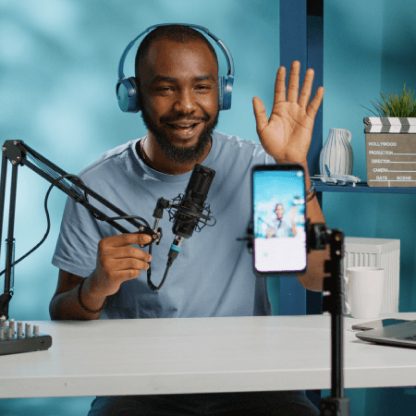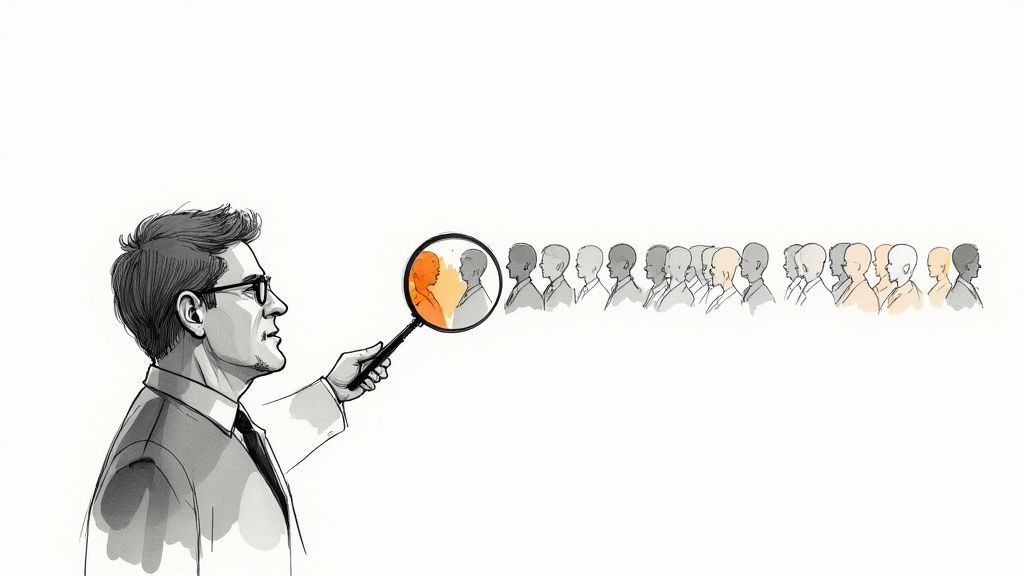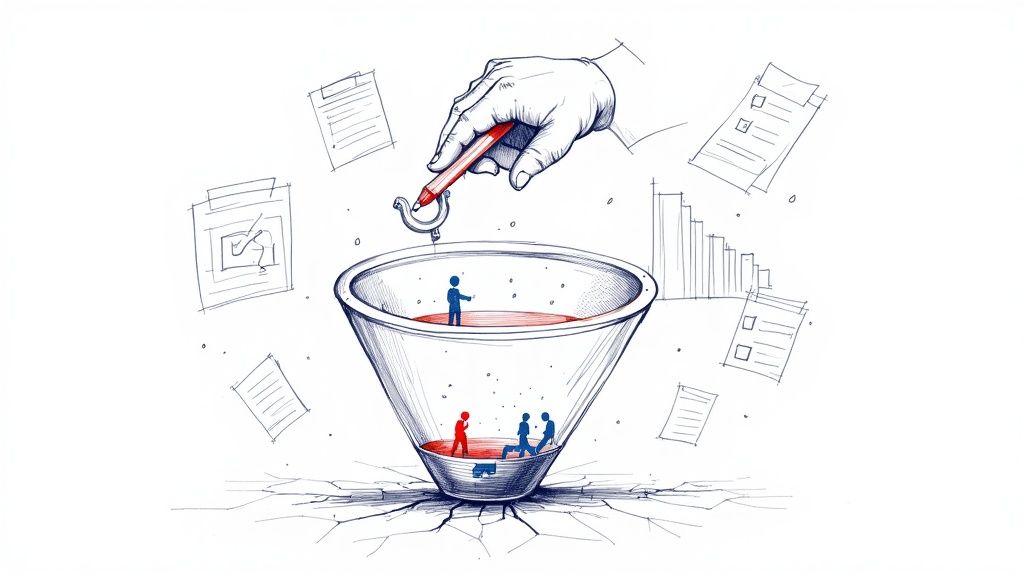If you’ve been asked to record a video interview, you're not alone. This isn't just a fleeting trend; it's a fundamental shift in how modern companies hire. Understanding why businesses have embraced this format is the first step to using it to your advantage.
Why Companies Use One-Way Video Interviews
Welcome to what's quickly becoming a new standard in hiring. Asynchronous, or "one-way," video interviews are now a key part of the recruitment process across a ton of industries, from tech and healthcare to retail and beyond. Companies aren't just doing this for convenience—it gives them a real strategic edge.
For one, it allows them to tap into a global talent pool without the logistical headache of coordinating schedules across a dozen different time zones. It also means hiring managers can review candidate submissions on their own time, leading to more thoughtful, consistent, and standardized evaluations for everyone.
But the biggest benefit for you, the candidate, is flexibility. You get to record your answers when you feel sharp and prepared, in a comfortable setting you control. It’s a world away from the pressure of a live, on-the-spot phone screen.
This whole process—from planning to recording—is really about solid preparation, not just your on-camera charm.

A Rapidly Growing Market
The move toward one-way interviews isn't just anecdotal; the numbers back it up. The global market for video interview software was already valued at USD 1.5 billion in 2023, and it's projected to explode to nearly USD 4.9 billion by 2032.
This massive growth is a clear signal that video interviews are here to stay, making it a crucial skill to master. Knowing how the process works from the inside out helps you turn the format into an opportunity. It's your chance to put your best foot forward and truly stand out in a crowded field.
If you want to dig a bit deeper, our article unveiling the dynamics of one-way video interviews is a great next step.
Setting Up a Professional Recording Environment
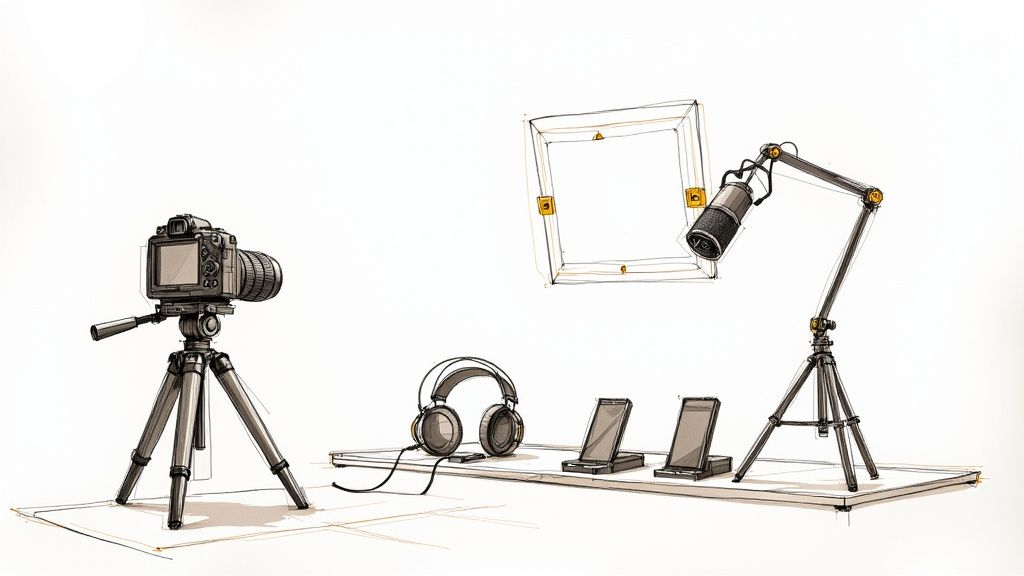
Before you even say a word, your recording space is making the first impression. To truly nail your video interview, you need a setting that keeps the focus squarely on you—not on a cluttered room or the distracting view from a window behind you.
Start by finding a spot with a simple, neutral background. A plain wall, a tidy bookshelf, or a single piece of art works perfectly. Your goal is to eliminate anything that could pull the recruiter’s attention away from your answers. Think of it as creating a clean stage where you are the main event.
Next up, let's talk about lighting. I’ve seen countless videos where poor lighting casts unflattering shadows or makes the video look grainy and amateur. You don’t need a fancy lighting kit, either. Honestly, a window with natural light is often your best bet.
The real trick is to position your main light source in front of you, not behind. Facing a window will light your face evenly and clearly, which helps you appear more engaged and makes it easier for the recruiter to connect with you.
Finally, you have to eliminate any potential background noise. This step is absolutely critical for ensuring your audio is crystal clear.
The Final Sound and Vision Check
This is the part everyone thinks they can skip, but it’s non-negotiable. Before you hit record, you need to be proactive about creating a quiet environment. This isn’t just about closing the door; it’s about anticipating interruptions before they happen.
I always tell people to:
- Give a heads-up: Let family, roommates, or anyone else in your home know you need a specific block of time without interruptions. Put a sign on the door if you have to!
- Silence all devices: This means your phone, computer notifications, and even smart home devices that might chime in unexpectedly.
- Secure your space: Close the door and any windows to buffer yourself from street noise or other sudden sounds.
To make sure you've got everything just right, I recommend running through a quick technical checklist. It only takes a minute and can save you a world of trouble.
Your Pre-Recording Technical Checklist
Follow this checklist to ensure your tech setup is perfect before you start your video interview.
| Check Area | What to Look For | Quick Tip |
|---|---|---|
| Camera | Is your face centered and at eye level? Is the video clear and not pixelated? | Stack books under your laptop to raise the camera to eye level. Clean your camera lens! |
| Microphone | Is your voice coming through clearly, without echo or muffled sounds? | Use headphones with a built-in mic. They are often better than your computer's default mic. |
| Lighting | Is your face evenly lit? Are there harsh shadows or is it too dark? | Sit facing a window. If that's not possible, place a lamp in front of you, slightly off to the side. |
| Background | Is it simple, tidy, and free of distractions? | A plain wall is best. If that’s not an option, a virtual background can work in a pinch, but a real, clean space is always better. |
| Internet | Is your connection stable? | Close any unnecessary tabs or applications that might be using up bandwidth. |
Once you’ve run through the list, do one last thing: record a 30-second test clip of yourself speaking. Watch it back and listen carefully. Is your face well-lit? Is your voice loud and clear? Are there any weird buzzing sounds or distracting items in the frame? This simple final check is your best defense against technical glitches that could otherwise sabotage an amazing performance.
Preparing Answers That Showcase Your Value
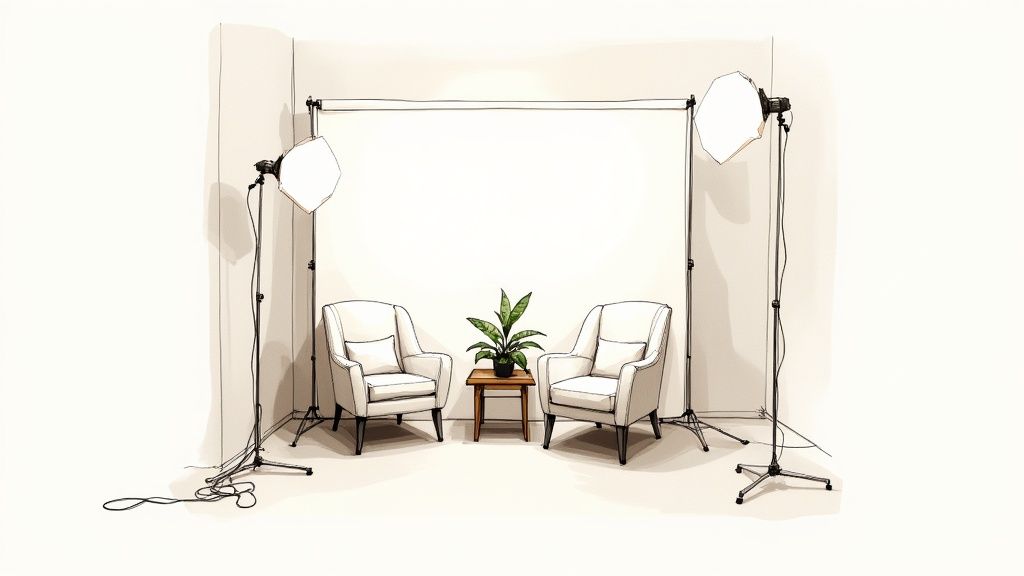
Acing a recorded interview is all about solid preparation. Your goal isn't just to list off your skills; it's to weave a compelling story about the value you bring. And every good story needs a structure.
This is your chance to really dissect the job description. Pinpoint the exact skills and qualifications the hiring manager is looking for. This allows you to stop giving generic answers and start crafting responses that show you're the solution to their specific problems.
The best way to do this? The STAR method. It's a simple framework that transforms your past experiences into memorable stories that recruiters can easily understand and remember.
This technique is your secret weapon for clearly and concisely showing your impact. It keeps you from rambling and forces you to get straight to the point: the results you delivered.
Structuring Answers With the STAR Method
The STAR method helps you build answers that are rich with detail but still easy to follow. Here’s a quick breakdown of how it works:
- Situation: Briefly paint the picture. What was the context or challenge? For instance, "In my previous role, our new mobile app was really struggling with low user engagement."
- Task: What exactly were you responsible for? "My job was to come up with and execute a new onboarding strategy to boost user retention by 15%."
- Action: Describe the specific steps you took. "I got a cross-functional team together to redesign the user flow, we added interactive tutorials, and I launched an email campaign to bring back dormant users."
- Result: End with the tangible outcome. Use numbers whenever you can to show real impact. "Because of this, we bumped up user engagement by 22% in just three months and saw early user churn drop by 30%."
This structured storytelling is gold in an asynchronous interview because it provides clarity and impact without needing any real-time follow-up questions from the hiring manager. For more strategies, you might find our guide on smart hiring with one-way and on-demand asynchronous interviews really helpful.
Practice Until It Feels Natural
Once you've mapped out your key stories using the STAR method, it’s time to practice. I'm not talking about memorizing a script—that can make you sound robotic. The goal here is to build confidence.
Grab your phone or use your laptop to record a video interview of yourself answering a few common questions.
Then, watch it back. Be your own harshest critic. Are you making eye contact with the camera? Is your pacing natural, or are you rushing? This process is invaluable for refining your delivery and body language so you come across as polished and authentic.
With the video interviewing software market valued at USD 0.41 billion in 2024, it's clear this skill is becoming essential. You can read more about the growth of video interviewing software to see just how big its impact is across every industry.
Mastering Your On-Camera Presence
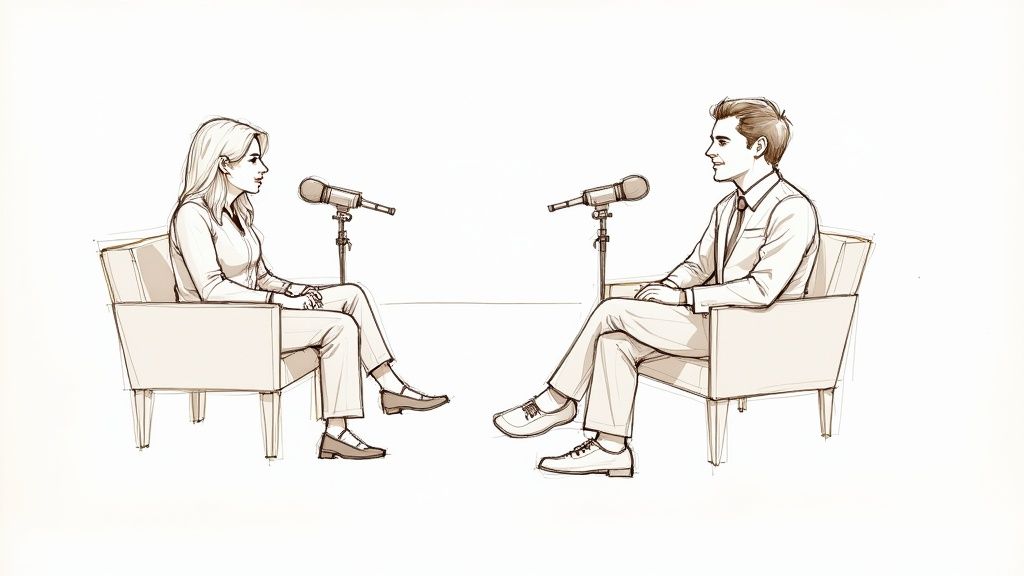
Alright, the moment you hit ‘record’ is your time to shine. All that prep work has set the stage, but it’s your on-camera presence that will truly connect you with the hiring manager and sell your personality.
Here’s the single most impactful thing you can do: look directly into the camera lens. Don't watch yourself on the screen. I know it feels a bit weird at first, but looking at the lens is the digital version of making eye contact. This tiny shift makes you seem worlds more engaged and confident.
Projecting Confidence and Enthusiasm
Your body language and voice are just as crucial as the words you're saying. Try not to sit stiff as a board. It's okay to use natural hand gestures to emphasize your points, just like you would in a real conversation. Leaning in slightly can also show that you're interested and paying attention.
Your vocal tone is another powerful tool. A monotone delivery can easily be mistaken for boredom or disinterest. Make a conscious effort to inject some energy and enthusiasm into your voice. You don't have to be over-the-top, just sound genuinely excited about the role.
Think of the camera as the hiring manager sitting right across the desk from you. Speak to it with warmth and professionalism. You're aiming to project composure and show you’re a great communicator.
Handling Mistakes Gracefully
So, what happens if you stumble over a word or completely lose your train of thought? First off, don't panic. It happens to the best of us.
- Take a breath. A short, calm pause to collect yourself is perfectly fine. It looks much better than trying to rush through a flustered recovery.
- Use retakes wisely. If the platform lets you re-record an answer, be strategic about it. It’s great for fixing a major blunder, but don't get obsessed with tiny imperfections. Sometimes, a bit of authenticity is more compelling than a perfectly polished, robotic delivery.
Nailing these on-camera skills gives you a massive advantage. For a deeper dive, check out our pro tips for success in your on-demand video interview to make sure you're fully prepared.
Reviewing and Submitting Your Interview
You’ve recorded your answers and you’re just a click away from the finish line. It's tempting to hit "submit" right away and be done with it, but hold on. A quick, deliberate review is your last, best chance to make sure all your preparation truly shines.
First, watch your entire recording from start to finish. Don't just skim it. More importantly, listen with a critical ear. Is your audio crisp and clear, or can you hear a faint buzz or your neighbor’s dog? Is the video stable and is your face well-lit? This final watch-through confirms your tech setup held up as well as your answers.
Don’t just check the tech; evaluate your performance. Did you actually answer the questions asked? Are you making good eye contact with the camera? Does your personality come through? This is the exact version the hiring manager will see, so make sure it's a strong one.
Once you’re satisfied, take a moment to double-check the submission details. Confirm the deadline and follow the platform's instructions to the letter. Don't let a simple mistake at the final step undermine your effort.
The Final Quality Control Check
This last check is about more than just your performance; it shows you understand the technology you’re being asked to use. The AI video interview market is on track to be a $1 billion industry by 2025, growing at a staggering 25% annual rate. It's rapidly changing how companies in competitive fields like finance, healthcare, and tech find their people.
By submitting a polished, professional video, you're signaling that you're comfortable with these modern tools. You can learn more about the trends in AI video interviewing and see why this skill is becoming so valuable. This final quality check ensures your video is a professional, polished representation of you.
Got a few last-minute questions before you hit record? It’s completely normal. Even the most prepared candidates have those nagging "what if" thoughts. Getting these common concerns sorted out will give you a nice confidence boost right before you start.
Let's clear up some of the most frequent questions we hear from candidates.
What Should I Wear for a Recorded Video Interview?
The rule of thumb is simple: dress exactly as you would for an in-person interview. For most roles, that means business professional or, at the very least, business casual. Even though you're at home, you’re signaling to the hiring team that you take this opportunity seriously.
Stick with solid, neutral colors like blues, grays, or even a crisp white. Busy patterns and super bright colors can be really distracting on camera and sometimes create a weird, shimmery effect. And I know it's tempting, but please don't just dress professionally from the waist up. You never know if you'll need to stand up or shift in your chair, so a complete outfit is always the safest and smartest choice.
Is It Okay to Use Notes During the Interview?
This one's a bit of a balancing act. You absolutely cannot read your answers directly from a script. It's painfully obvious to whoever is watching and makes you come across as stiff and unnatural. Your answers will sound robotic, and you'll lose that spark of personality that helps you connect with the hiring manager.
That said, having a few key bullet points on a sticky note just off-camera is perfectly fine. Think of it as a quick reference to jog your memory, not a teleprompter.
Your notes are a safety net, not a crutch. This little trick helps you keep a conversational flow and maintain natural eye contact with the camera, which is way more engaging for the viewer.
How Can I Show My Personality on Camera?
Letting your personality shine through a screen means you have to be a little more intentional and expressive than you might be in person. Make a conscious effort to smile genuinely where it feels natural, use your hands to add emphasis as you speak, and vary your tone of voice to show you're truly interested.
Sit up straight—it instantly makes you look more engaged. You can even lean in slightly to show you're locked in on the question. But most importantly, just let your passion for the role come through. Talk to the camera like you're talking to a person in the room with you. Your authentic self is your biggest asset.
Ready to streamline your hiring process and discover top talent faster? Async Interview makes it easy to create a professional and engaging candidate experience. Start your free trial today and hire up to ten times faster!
